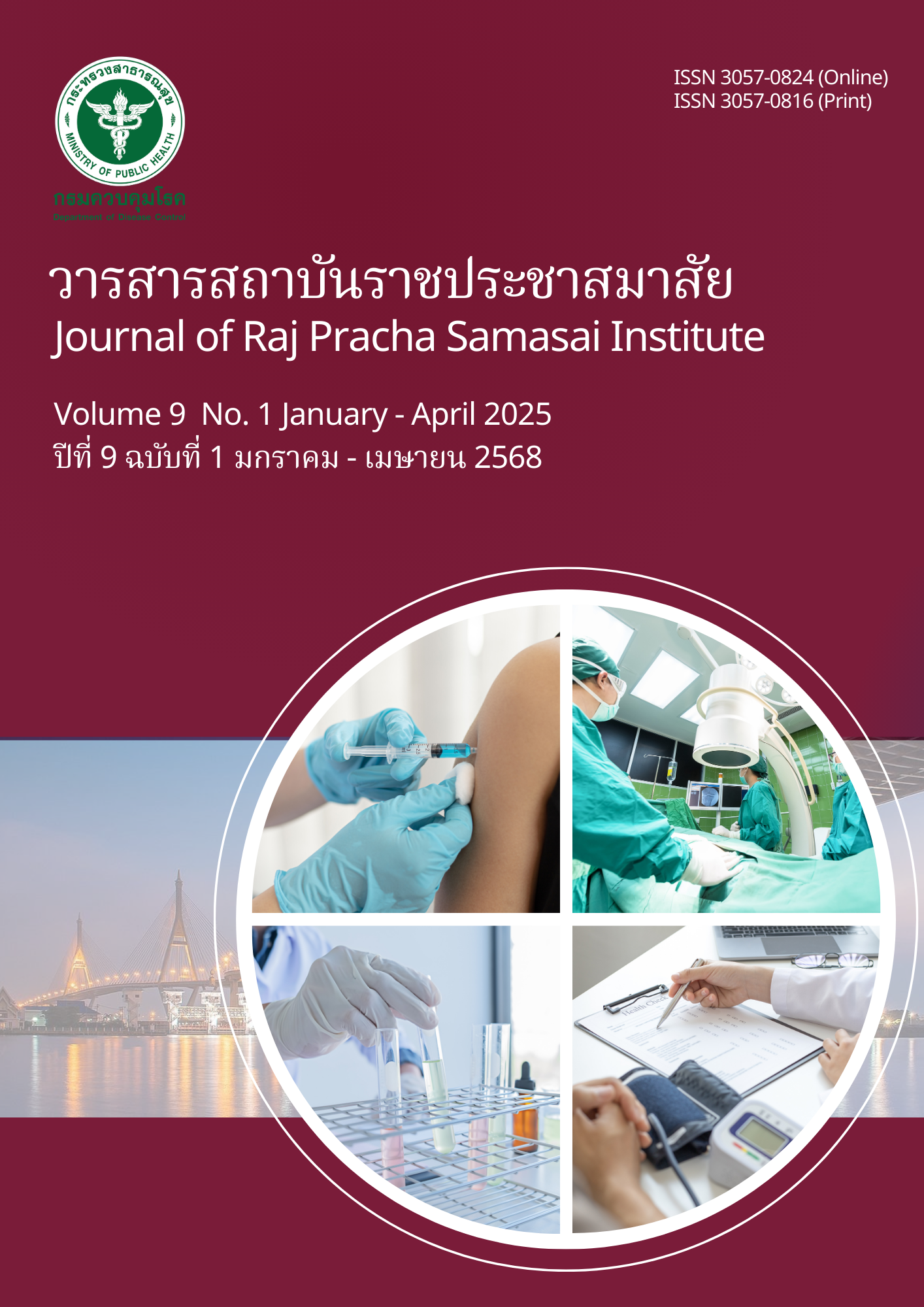Application of the World Health Organization's Leprosy Elimination Framework for the Epidemiological Classification of Leprosy Indicator Districts in Thailand
Main Article Content
Abstract
This study aims to detect and analyze the distribution of new leprosy cases according to the World Health Organization's (WHO) leprosy elimination framework by using Thailand leprosy data from 2000 to 2023. It focused on recent transmission and their epidemiological linkages. The primary objective was to describe the spatial distribution of leprosy cases at the district level and categorize districts into epidemiological phases based on the WHO framework. Advanced mapping tools were employed to visualize district classifications and assess their alignment with present criteria, which particularly emphasized the number of new cases. Statistical measures, including frequency, percentage, and Cohen’s Kappa (K) were applied to evaluate the agreement between the WHO framework and existing classification methods.
The analysis covered 928 districts nationwide, highlighting substantial progress in leprosy elimination over the past two decades. As of 2023, 7 districts were classified as Phase 1 until transmission interruption, 62 districts as Phase 2 from transmission interruption to disease elimination, 241 districts as Phase 3 post-elimination surveillance, and 618 districts as non-endemic status. Comparing the district classification of epidemiological indicators using two different criteria, with districts in Phases 1 and 2 designated as indicator districts between 2023 and 2025, It was found that the classification based on the WHO leprosy elimination framework identified more indicator districts than the present criteria. The observed agreement rates were 91%, 93%, and 94%, with Cohen’s Kappa (K) values of 0.481, 0.498, and 0.527, indicating a moderate level of agreement.
The spatial analysis highlighted the geographical concentration of districts that have yet to achieve leprosy elimination. These districts are predominantly located in certain provinces of the northeastern region, as well as in Pattani and Narathiwat provinces in the south. Strengthening surveillance and control measures to address these persistent hotspots is strongly suggested. A dual strategy is advised: passive case detection through community education and awareness, alongside active case detection via contact screening. Enhancing community engagement and early detection capacity is crucial for accelerating leprosy elimination in high-risk areas.
The findings emphasize the importance of adopting the WHO leprosy elimination framework for district-level classification of leprosy epidemiological indicators. By employing this standardized approach, national leprosy control programs can enhance progress monitoring, accurately identify high-burden areas, and optimize resource allocation. Public health authorities must collaborate strategically with leprosy control experts and other key stakeholders to achieve more effective and sustainable leprosy elimination. This integrated approach will strengthen efforts to achieve the WHO's goal of leprosy elimination in Thailand and facilitate timely, evidence-based interventions in endemic districts.
Downloads
Article Details

This work is licensed under a Creative Commons Attribution-NonCommercial-NoDerivatives 4.0 International License.
ประกาศเกี่ยวกับลิขสิทธิ์
บทความที่ลงพิมพ์ในวารสารสถาบันราชประชาสมาสัย ถือว่าเป็นผลงานทางวิชาการหรือการวิจัย และวิเคราะห์ตลอดจนเป็นความเห็นส่วนตัวของผู้นิพนธ์ ไม่ใช่ความเห็นของกรมควบคุมโรค ประเทศไทย หรือกองบรรณาธิการแต่ประการใด ผู้นิพนธ์จำต้องรับผิดชอบต่อบทความของตน
นโยบายส่วนบุคคล
ชื่อและที่อยู่อีเมลที่ระบุในวารสารสถาบันราชประชาสมาสัย จะถูกใช้เพื่อวัตถุประสงค์ตามที่ระบุไว้ ในวารสารเท่านั้น และจะไม่ถูกนำไปใช้สำหรับวัตถุประสงค์อื่น หรือต่อบุคคลอื่นใด
References
Department of Disease Control (TH), Raj Pracha Samasai Institute. Guideline for the diagnosis and treatment of leprosy. Nakhon Pathom: The Printing House of the National Office of Buddhism; 2010. 1-154 p. (in Thai)
Department of Disease Control (TH), Raj Pracha Samasai Institute. Leprosy Situation [Internet]. Nonthaburi: Raj Pracha Samasai Institute; 2024 [cited 2024 Apr 1]. Available from: http://rajpracha.ddc.moph.go.th/site/satus_lep.html (in Thai)
Chua-intra B. Effectiveness of accelerating strategy for new case findings in districts with epidemiological indications and impact on leprosy-free Thailand [Internet]. Nonthaburi. Raj Pracha Samasai Institute; 2566 [cited 2024 Jan 1]. 26 p. Available from: http://rajpracha.ddc.moph.go.th/site/documents/research/Research67.pdf (in Thai)
World Health Organization. Interruption of transmission and elimination of leprosy disease -Technical guidance [Internet]. New Delhi. WHO South-East Asia; 2023 [cited 2024 Jan 1]. 81 p. Available from: https://www.who.int/publications/i/item/9789290210467
World Health Organization. Leprosy elimination monitoring tool [Internet]. New Delhi. WHO South-East Asia; 2023 [cited 2024 Jan 1]. 16 p. Available from: https://www.who.int/publications/i/item/9789290210474
Department of Disease Control (TH), Raj Pracha Samasai Institute. List of Target Areas for New Case Finding of Leprosy [Internet]. Bangkok. 2024 [cited 2024 Apr 1]. Available from: http://rajpracha.ddc.moph.go.th/site/area.html (in Thai)
Jirawatkul A. Measure of Agreement for Categorical Data by Kappa. Journal of Health Science of Thailand [Internet]. 2009 [cited 2024 Jan 1];18(5):641-2. Available from: https://thaidj.org/index.php/JHS/article/view/1795 (in Thai)
Sermrittirong S, Thanyakittiku P. Evaluation of the effectiveness of leprosy elimination program under the 11th ed. National Health Development Plan 2012-2016. J Off DPC 7 Khon Kaen [Internet]. 2018 [cited 2024 Aug. 1];25(3):109-20. Available from: https://he01.tci-thaijo.org/index.php/jdpc7kk/article/view/166771 (in Thai)
Taechatrisa C. Epidemiology of leprosy in Thailand after successful elimination of leprosy as a public health problem from 1994-2016. Dis Control J [Internet]. 2018 [cited 2024 Aug. 1];44(3): 325-36. Available from: https://he01.tci-thaijo.org/index.php/DCJ/article/view/148054 (in Thai)


